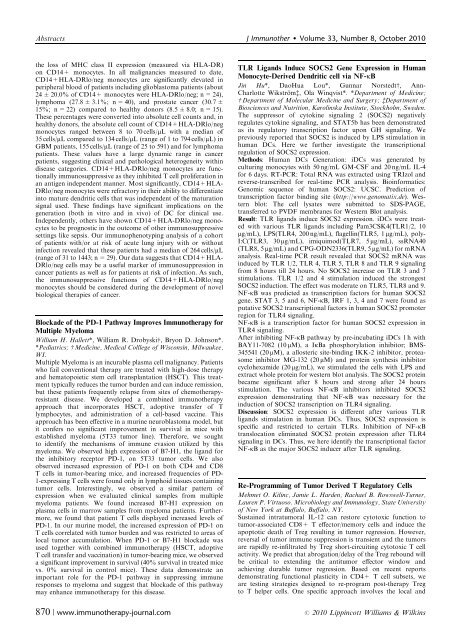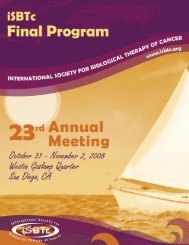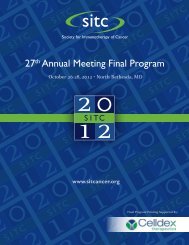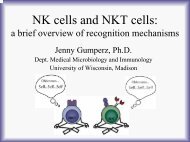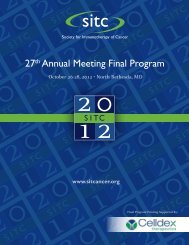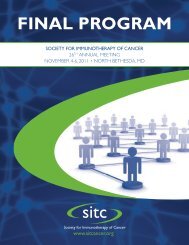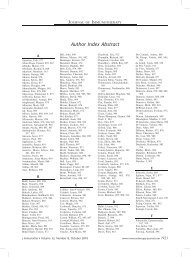Abstracts for the 25th Annual Scientific Meeting of the International ...
Abstracts for the 25th Annual Scientific Meeting of the International ...
Abstracts for the 25th Annual Scientific Meeting of the International ...
Create successful ePaper yourself
Turn your PDF publications into a flip-book with our unique Google optimized e-Paper software.
<strong>Abstracts</strong> J Immuno<strong>the</strong>r Volume 33, Number 8, October 2010<br />
<strong>the</strong> loss <strong>of</strong> MHC class II expression (measured via HLA-DR)<br />
on CD14+ monocytes. In all malignancies measured to date,<br />
CD14+HLA-DRlo/neg monocytes are significantly elevated in<br />
peripheral blood <strong>of</strong> patients including glioblastoma patients (about<br />
24 ± 20.0% <strong>of</strong> CD14+ monocytes were HLA-DRlo/neg; n = 24),<br />
lymphoma (27.8 ± 3.1%; n = 40), and prostate cancer (30.7 ±<br />
15%; n = 22) compared to healthy donors (8.5 ± 8.0; n = 15).<br />
These percentages were converted into absolute cell counts and, in<br />
healthy donors, <strong>the</strong> absolute cell count <strong>of</strong> CD14+HLA-DRlo/neg<br />
monocytes ranged between 8 to 70 cells/mL with a median <strong>of</strong><br />
35 cells/mL compared to 134 cells/mL (range <strong>of</strong> 1 to 794 cells/mL) in<br />
GBM patients, 155 cells/mL (range <strong>of</strong> 25 to 591) and <strong>for</strong> lymphoma<br />
patients. These values have a large dynamic range in cancer<br />
patients, suggesting clinical and pathological heterogeneity within<br />
disease categories. CD14+HLA-DRlo/neg monocytes are functionally<br />
immunosuppressive as <strong>the</strong>y inhibited T cell proliferation in<br />
an antigen independent manner. Most significantly, CD14+HLA-<br />
DRlo/neg monocytes were refractory in <strong>the</strong>ir ability to differentiate<br />
into mature dendritic cells that was independent <strong>of</strong> <strong>the</strong> maturation<br />
signal used. These findings have significant implications on <strong>the</strong><br />
generation (both in vitro and in vivo) <strong>of</strong> DC <strong>for</strong> clinical use.<br />
Independently, o<strong>the</strong>rs have shown CD14+HLA-DRlo/neg monocytes<br />
to be prognostic in <strong>the</strong> outcome <strong>of</strong> o<strong>the</strong>r immunosuppressive<br />
settings like sepsis. Our immunophenotyping analysis <strong>of</strong> a cohort<br />
<strong>of</strong> patients with/or at risk <strong>of</strong> acute lung injury with or without<br />
infection revealed that <strong>the</strong>se patients had a median <strong>of</strong> 264 cells/mL<br />
(range <strong>of</strong> 31 to 1443; n = 29). Our data suggests that CD14+HLA-<br />
DRlo/neg cells may be a useful marker <strong>of</strong> immunosuppression in<br />
cancer patients as well as <strong>for</strong> patients at risk <strong>of</strong> infection. As such,<br />
<strong>the</strong> immunosuppressive functions <strong>of</strong> CD14+HLA-DRlo/neg<br />
monocytes should be considered during <strong>the</strong> development <strong>of</strong> novel<br />
biological <strong>the</strong>rapies <strong>of</strong> cancer.<br />
Blockade <strong>of</strong> <strong>the</strong> PD-1 Pathway Improves Immuno<strong>the</strong>rapy <strong>for</strong><br />
Multiple Myeloma<br />
William H. Hallett*, William R. Drobyskiw, Bryon D. Johnson*.<br />
*Pediatrics; w Medicine, Medical Colllege <strong>of</strong> Wisconsin, Milwaukee,<br />
WI.<br />
Multiple Myeloma is an incurable plasma cell malignancy. Patients<br />
who fail conventional <strong>the</strong>rapy are treated with high-dose <strong>the</strong>rapy<br />
and hematopoietic stem cell transplantation (HSCT). This treatment<br />
typically reduces <strong>the</strong> tumor burden and can induce remission,<br />
but <strong>the</strong>se patients frequently relapse from sites <strong>of</strong> chemo<strong>the</strong>rapyresistant<br />
disease. We developed a combined immuno<strong>the</strong>rapy<br />
approach that incorporates HSCT, adoptive transfer <strong>of</strong> T<br />
lymphocytes, and administration <strong>of</strong> a cell-based vaccine. This<br />
approach has been effective in a murine neuroblastoma model, but<br />
it confers no significant improvement in survival in mice with<br />
established myeloma (5T33 tumor line). There<strong>for</strong>e, we sought<br />
to identify <strong>the</strong> mechanisms <strong>of</strong> immune evasion utilized by this<br />
myeloma. We observed high expression <strong>of</strong> B7-H1, <strong>the</strong> ligand <strong>for</strong><br />
<strong>the</strong> inhibitory receptor PD-1, on 5T33 tumor cells. We also<br />
observed increased expression <strong>of</strong> PD-1 on both CD4 and CD8<br />
T cells in tumor-bearing mice, and increased frequencies <strong>of</strong> PD-<br />
1-expressing T cells were found only in lymphoid tissues containing<br />
tumor cells. Interestingly, we observed a similar pattern <strong>of</strong><br />
expression when we evaluated clinical samples from multiple<br />
myeloma patients. We found increased B7-H1 expression on<br />
plasma cells in marrow samples from myeloma patients. Fur<strong>the</strong>rmore,<br />
we found that patient T cells displayed increased levels <strong>of</strong><br />
PD-1. In our murine model, <strong>the</strong> increased expression <strong>of</strong> PD-1 on<br />
T cells correlated with tumor burden and was restricted to areas <strong>of</strong><br />
local tumor accumulation. When PD-1 or B7-H1 blockade was<br />
used toge<strong>the</strong>r with combined immuno<strong>the</strong>rapy (HSCT, adoptive<br />
T cell transfer and vaccination) in tumor-bearing mice, we observed<br />
a significant improvement in survival (40% survival in treated mice<br />
vs. 0% survival in control mice). These data demonstrate an<br />
important role <strong>for</strong> <strong>the</strong> PD-1 pathway in suppressing immune<br />
responses to myeloma and suggest that blockade <strong>of</strong> this pathway<br />
may enhance immuno<strong>the</strong>rapy <strong>for</strong> this disease.<br />
TLR Ligands Induce SOCS2 Gene Expression in Human<br />
Monocyte-Derived Dendritic cell via NF-kB<br />
Jin Hu*, DaoHua Lou*, Gunnar Norstedtw, Ann-<br />
Charlotte Wikströmz, Ola Winqvist*. *Department <strong>of</strong> Medicine;<br />
w Department <strong>of</strong> Molecular Medicine and Surgery; zDepartment <strong>of</strong><br />
Biosciences and Nutrition, Karolinska Institute, Stockholm, Sweden.<br />
The suppressor <strong>of</strong> cytokine signaling 2 (SOCS2) negatively<br />
regulates cytokine signaling, and STAT5b has been demonstrated<br />
as its regulatory transcription factor upon GH signaling. We<br />
previously reported that SOCS2 is induced by LPS stimulation in<br />
human DCs. Here we fur<strong>the</strong>r investigate <strong>the</strong> transcriptional<br />
regulation <strong>of</strong> SOCS2 expression.<br />
Methods: Human DCs Generation: iDCs was generated by<br />
culturing monocytes with 50 ng/mL GM-CSF and 20 ng/mL IL-4<br />
<strong>for</strong> 6 days. RT-PCR: Total RNA was extracted using TRIzol and<br />
reverse-transcribed <strong>for</strong> real-time PCR analysis. Bioin<strong>for</strong>matics:<br />
Genomic sequence <strong>of</strong> human SOCS2: UCSC. Prediction <strong>of</strong><br />
transcription factor binding site (http://www.genomatix.de). Western<br />
blot: The cell lysates were submitted to SDS-PAGE,<br />
transferred to PVDF membranes <strong>for</strong> Western Blot analysis.<br />
Result: TLR ligands induce SOCS2 expression. iDCs were treated<br />
with various TLR ligands including Pam3CSK4(TLR1/2, 10<br />
mg/mL), LPS(TLR4, 200 ng/mL), flagellin(TLR5, 1 mg/mL), poly-<br />
I:C(TLR3, 30 mg/mL), imiquimod(TLR7, 5 mg/mL), ssRNA40<br />
(TLR8, 5 mg/mL) and CPG-ODN2336(TLR9, 5 mg/mL) <strong>for</strong> mRNA<br />
analysis. Real-time PCR result revealed that SOCS2 mRNA was<br />
induced by TLR 1/2, TLR 4, TLR 5, TLR 8 and TLR 9 signaling<br />
from 8 hours till 24 hours. No SOCS2 increase on TLR 3 and 7<br />
stimulations. TLR 1/2 and 4 stimulation induced <strong>the</strong> strongest<br />
SOCS2 induction. The effect was moderate on TLR5, TLR8 and 9.<br />
NF-kB was predicted as transcription factors <strong>for</strong> human SOCS2<br />
gene. STAT 3, 5 and 6, NF-kB, IRF 1, 3, 4 and 7 were found as<br />
putative SOCS2 transcriptional factors in human SOCS2 promoter<br />
region <strong>for</strong> TLR4 signaling.<br />
NF-kB is a transcription factor <strong>for</strong> human SOCS2 expression in<br />
TLR4 signaling.<br />
After inhibiting NF-kB pathway by pre-incubating iDCs 1 h with<br />
BAY11-7082 (10 mM), a IkBa phosphorylation inhibitor; BMS-<br />
345541 (20 mM), a allosteric site-binding IKK-2 inhibitor, proteasome<br />
inhibitor MG-132 (20 mM) and protein syn<strong>the</strong>sis inhibitor<br />
cyclohexamide (20 mg/mL), we stimulated <strong>the</strong> cells with LPS and<br />
extract whole protein <strong>for</strong> western blot analysis. The SOCS2 protein<br />
became significant after 8 hours and strong after 24 hours<br />
stimulation. The various NF-kB inhibitors inhibited SOCS2<br />
expression demonstrating that NF-kB was necessary <strong>for</strong> <strong>the</strong><br />
induction <strong>of</strong> SOCS2 transcription on TLR4 signaling.<br />
Discussion: SOCS2 expression is different after various TLR<br />
ligands stimulation in human DCs. Thus, SOCS2 expression is<br />
specific and restricted to certain TLRs. Inhibition <strong>of</strong> NF-kB<br />
translocation eliminated SOCS2 protein expression after TLR4<br />
signaling in DCs. Thus, we here identify <strong>the</strong> transcriptional factor<br />
NF-kB as <strong>the</strong> major SOCS2 inducer after TLR signaling.<br />
Re-Programming <strong>of</strong> Tumor Derived T Regulatory Cells<br />
Mehmet O. Kilinc, Jamie L. Harden, Rachael B. Rowswell-Turner,<br />
Lauren P. Virtuoso. Microbiology and Immunology, State University<br />
<strong>of</strong> New York at Buffalo, Buffalo, NY.<br />
Sustained intratumoral IL-12 can restore cytotoxic function to<br />
tumor-associated CD8+ T effector/memory cells and induce <strong>the</strong><br />
apoptotic death <strong>of</strong> Treg resulting in tumor regression. However,<br />
reversal <strong>of</strong> tumor immune suppression is transient and <strong>the</strong> tumors<br />
are rapidly re-infiltrated by Treg short-circuiting cytotoxic T cell<br />
activity. We predict that abrogation/delay <strong>of</strong> <strong>the</strong> Treg rebound will<br />
be critical to extending <strong>the</strong> antitumor effector window and<br />
achieving durable tumor regression. Based on recent reports<br />
demonstrating functional plasticity in CD4+ T cell subsets, we<br />
are testing strategies designed to re-program post-<strong>the</strong>rapy Treg<br />
to T helper cells. One specific approach involves <strong>the</strong> local and<br />
870 | www.immuno<strong>the</strong>rapy-journal.com r 2010 Lippincott Williams & Wilkins


